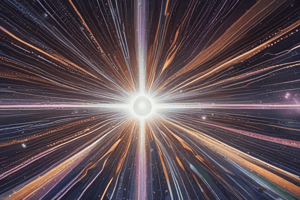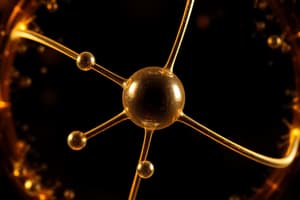Podcast
Questions and Answers
What is the magnitude of the total electric force that q1 and q2 exert on the third charge Q?
What is the magnitude of the total electric force that q1 and q2 exert on the third charge Q?
- $167.4 \, \text{N/C}$
- $131.6 \, \text{N/C}$ (correct)
- $128.4 \, \text{N/C}$
- $150.6 \, \text{N/C}$
What is the direction of the total electric force that q1 and q2 exert on the third charge Q?
What is the direction of the total electric force that q1 and q2 exert on the third charge Q?
- Counter-clockwise from the +ve x-axis (correct)
- Clockwise from the +ve x-axis
- Below the -ve y-axis
- Above the +ve x-axis
In which quadrant does the third charge Q reside?
In which quadrant does the third charge Q reside?
- Quadrant IV
- Quadrant I (correct)
- Quadrant II
- Quadrant III
What is the value of θ in degrees for the direction of the resultant electric field?
What is the value of θ in degrees for the direction of the resultant electric field?
What is the location of q2 with respect to the origin?
What is the location of q2 with respect to the origin?
What is the vector sum of electric fields at a point due to multiple charges?
What is the vector sum of electric fields at a point due to multiple charges?
In which direction does the electric field produced by a negative point charge point?
In which direction does the electric field produced by a negative point charge point?
What are the rules for drawing electric field lines?
What are the rules for drawing electric field lines?
What defines an electric dipole?
What defines an electric dipole?
How is the magnitude of an electric dipole moment defined?
How is the magnitude of an electric dipole moment defined?
What is the direction of the dipole moment in an electric dipole?
What is the direction of the dipole moment in an electric dipole?
What is the electrostatic force between an electron-proton pair?
What is the electrostatic force between an electron-proton pair?
What is the gravitational force between an electron-proton pair?
What is the gravitational force between an electron-proton pair?
At what point are the two point charges located in the answer provided?
At what point are the two point charges located in the answer provided?
What is the magnitude of the electric field at the origin due to charge $q_1$?
What is the magnitude of the electric field at the origin due to charge $q_1$?
What is the direction of the electric field at the origin due to charge $q_1$?
What is the direction of the electric field at the origin due to charge $q_1$?
What is the sign of the charge $q_1$ provided in the answer?
What is the sign of the charge $q_1$ provided in the answer?
Flashcards are hidden until you start studying
Study Notes
Electric Field
- Electric field is a force that surrounds a point charge and is proportional to the magnitude of the charge and inversely proportional to the square of the distance from the charge.
- The electric field produced by a positive point charge points away from the charge, and the electric field produced by a negative point charge points toward the charge.
Electric Field Calculations
- Electric field at a point due to many charges is the vector sum of the individual electric fields.
- Electric field can be calculated using the formula: E = 1 / (4πε0) * (Q / r²)
Electric Field Lines
- Electric field lines are imaginary lines or curves that represent the direction of the electric field vector at a point.
- Rules for drawing electric field lines:
- Start at positive charges and end at negative charges.
- The number of lines leaving a positive charge or terminating on a negative charge is proportional to the charge.
- The number of lines per unit area perpendicular to the lines is proportional to the electric field.
- No two field lines can ever intersect.
Electric Dipole
- An electric dipole is a pair of electric charges of equal magnitude but opposite sign, separated by a small distance.
- The magnitude of the electric dipole moment (p) is given by: p = qd
- The direction of the dipole moment (p) is from the negative to the positive charge.
Electric Field Due to Multiple Charges
- The resultant electric field at a point is the vector sum of the individual electric fields due to each charge.
- The electric field can be calculated using the formula: E = E1 + E2 + ...
Electric Force and Gravitational Force
- The electrostatic force between an electron and a proton is much stronger than the gravitational force between them.
- The ratio of the electrostatic force to the gravitational force is: Fe / Fg = 2.23 x 10^39
Studying That Suits You
Use AI to generate personalized quizzes and flashcards to suit your learning preferences.




